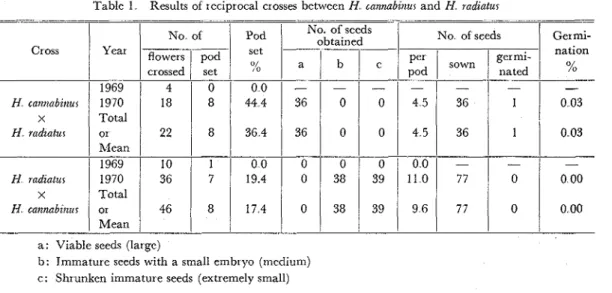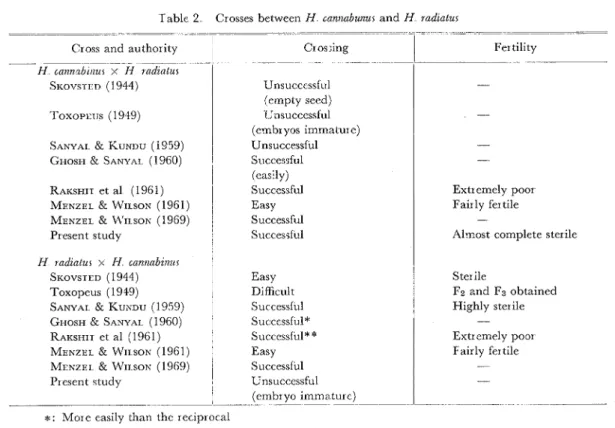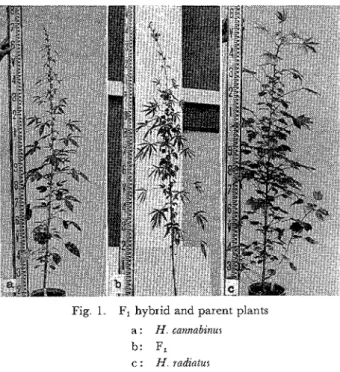Tech Bull Fac Agt Kagawa Univ Vol 28, No GO, 19-22, 1977 19
F, HYBRIDS OBTAINED F R O M HIBISCUS CANNABINUS
x
H RADIATUS, W I T H REFERENCE T O T H E GENOME RELATIONSHIP(Studies on interspecific and intergeneric hybridizatio11 in the Malvaccae XV)
Hzbzscus cannabznus X H radzatus 0 F, @#j
( 7 & / f H O @ ,
RPd3#@t~M$6@f%
XV)Reciprocal crosses wcrc made between
N
cannabznur (2n=36) andN
radzatur (2n=72). An F1 plant was obtained only whcnN
cannabznur was used as the fcmale parent The F1 plant grew vigorously and was totally stcrilc In pollen mothcr cclls, 111,,-1- 18, was most fregucntly obsclvcd Judging from these rcsults, the tctraploid spccics, H radzutur, contains one genome wliich is homologous with that of I1 cannabznus and anothcr gcnomc which is notH. cannabznus (2n=36)
t
H radzatus (2n=72) t OiIiEHE2#"i it,ii
% @ i3BC.Z L R g 6 8 4 , 2 # 2 i l & ~ J ~ L 7': F,( a 2
L { %dU%QZ Lf:di,%2l.=m%r
5
-,
f: R Mi@~.I&lW4~%0za:&C-k 2n=54-c,
rjli?$\5>%i-c i b k % 5 > D / f d $ ~ 1811 i 181 9 3 1.7': L7':di 3 T , N radzakir I? k l , H cannabznus t+B'nl;rlO/i / 1 7 t, 2< % $ H H O i I Y I a
l 7 Q h f
L t # % L f :Introduction
Studies of thc cl~romosome nunlber of
N
cannabznus and H radzatur havc been made by SKOVSTED (1 944) (m),TOXOPEUS
(1 947)(12) and TJIO (I 948) (111, and these two species were found to bc 2n=36 diploid and 2n=72 tctraploid, respectively Scveral studies of thc interspecific hybridization bctween thcsc two species have bcen madc, investigating thc clongation of pollcn tube in reciprocal crossing(8), their crossability("J 12j I ) , the genome relationship(g,7> 394.596).The interspecific hybridization of H acetorella (2n=72) and
H
cannabinur (2n=36) has been reported previously(2) as a series of studies on the interspecific and intergeneric hybridi- zations in the Malvaceae The present paper reports the results of the hybrid ofN
cannabznusx
H radzatur, and somc considcrations will be also given to their genome relationship.Materials and Methods
The materials used in this study were t h e e cultivars of
Zi
cannabznus, "Hyderabat" (No 2), "Ariyabas" (No 5 ) which uerc obtained from Indian Agricullural Rcsearch Institute, "Tashikent" (No 6) which was maintained in our laboratory, and one cultivar ofN
radzatzlr which was obtained from Florida State University, Tallahassee, Florida, US
APlants for crossing, with the exception of "Tashikcnt" (No 6), were grown in a green house under a short-day treatment Emasculation was made in the afternoon before the opening
OLIVE 香川大学学術情報リポジトリ
20 Iiikaru Kuwada Tech.. Bull Fac Agr
.
Kagawa Univ. of flowers Crosses wcre madc by touching the stigma with the staminal column of the pollen parent.Buds for cytological study were peeled to expose the staminal column, fixed in fresh acetic alcohol and stored in a refrigerated 70% alcohol solution. Meiotic and mitotic chromosomes were studied by temporary acetic orcein squash of PMC's and of root tips, respectively.
Results and Discussion 1. Crossing
The data for reciprocal crosses between H, cannabinur and H. radiatus are given in Table 1. Table 1 Results of reciprocal crosses between H cannabznur and H radzatur
a : Viable seeds (large)
b: Immature seeds with a small embryo (medium) c: Shrunken immature seeds (extremely small)
Although the numbcr of flowers used in crossing was small, the percentage of pod setting for H. cannabinur
x
H radzatus was higher than for the reciprocal cross. A number of large viable seeds were obtained from H. cannabznur x H radzatur, but from the reciprocal cross, the only seeds obtained were either medium and immature, with a small embryo, or small, shrunken and immatureThe germination of the F1 seeds obtained from reciprocal crossing was very poor, and only one seed obtained from H cannabznur x H radzatus germinated, consequently only one F1 plant from this cross combination was obtained The cause of the poor germination of F1 seeds ob- tained from the reciprocal crossing remains unknown, but seems to be due to the genetical differences of the chromosomes and genomes of the parent plants
The results of crossing experiments are summarized in Table 2. The success of this species- crossing differs with different investigators, that is, there some authors who succeeded in crossing in both directions, with only a difference in the degree of difficulty experienced, depending on the cross direction, while there are somc authors who succceded in crossing in only one direction,
2. Characteristics of
Fl
The charateristics of the F1 plant are compared with those of the parents in Table 3. The F1 and its parents are shown in Fig. 1. The F1 plant grew vigorously, showing heterosis I t was taller, had more nodcs and branches and larger leavcs and a bigger stem than its parents.
No of sccds gcr mi-
/
sown/
pod nated .- Cross Ger mi- nation % - No. of seeds obtained aI
b_l
c X H radzatur H cannabztzur - 1970 Total or 46 17 4 38 39 9 6 77 0 00 Mean H cannabznur x H radzatur 0 0 4 5 4 5 1969 1970 Total or Mean 36 36 4 4 4 364 4 18 22o
o
-
-
-
-0 0-
36 36 0 8 8/
O o 3OLIVE 香川大学学術情報リポジトリ
Vol 28, No 60 (1977) F, hybrids of H cannabznur x H radzatzir 21 Table 2 Crosses between H cannabunur and EZ radzatur
-- -- -
-
-
-- -- - -- -- --- - - - -. -- - -- -- ---- -- -I
Cross and authority Cros;ing
I
FertilityRAKSMII et a1 (1961) MENZEL & WILSON (1961) MENZEL & WILSON (1969) Present study - - -- -. - -- - H cannzblnur x N radzalur S1tov71 r n (1 944) T o x o ~ ~ r i s (1 9 19) H radzatur x H cannabznur SKOVSTED (1944) Toxopeus (1919) SANYAL & KUWDU (1959) GHOSH & SANYAL (1960) RAKSIIIT et a1 (1961) MENZEL & WILSON (1961) M E N Z E L & WIISON (1969) Present study . - Unsucccssf~rl (empty seed) 1 JL~successful (embryos immature) Unsuccessful Successful ieaslly) Successful Easy Successful Successful Easy Difficult Successful SuccessfulY Successful*
*
Easy Successful Unsucccssful (cmbryo immature) .- -o : More easily than thc reciprocal
**:
T h e pcrcentagc of pod sctting was molc than thc reciprocalTable 3 Characteristics of F1 and parent plants
- - - . -- - - - - - - - - - - - - --- Characteristics
I
H cannabznur1
FII
Extremely poor Fairly fertile -Almost complete sterile
Sterile Fz and F3 obtained Highly sterile Extremely poor Fairly fertile - -. - Plant height (cm) Stem Petiole Lamina Green Prickles 0 Green Prickles 0 5 deeply palmately lobed, margin serrated, Green Green Prickles a few Green, partially light red-purple, light red-purple prickles a few 3 - 7 deeply palmately lobed, margin deeply serrated, Green with light red-purple margin - - - . - . ~ ~. . H radzatur 181.0 Green Prickles a few Green, partially light red-purple, r ed-pur ple prickles a few 5 deeply palmately lobed, margin deeply serrated, Green with red- purple margin
T h e green stem color and green leaf color of the F1 plant was the same as it's parents' T h e colors of the leaf margin and petiole of the F1 plant resembled the H radzatur in which they are
light red-purple, while those of H cannabznur are green T h e F1 plant has a few prickles on the petiole resembling H radzatur
T h e leaf shape of the F1 plant was intermediate between it's parents, but the width of lamina of the F1 leaves were somewhat wider than average value of it's parents' T h e lamina width of H cannabznur is narrow while that of H radzatur is comparatively broad At a n early stage
OLIVE 香川大学学術情報リポジトリ
Hikaru Kuwada T e c h Bull Fac Agr Kagawa U n i v
Fig 1 F1 hybrid and parent plants a : H cannabznur b : F,
c : H radzatur
in the first year of growth the young leaves at the upper part of the F1 plant were 5-lobed, but a t the lower part 3-lobed, resembling to H radzatur
3. Chromosome numbers and meiosis of the F1 plant
The chromosome numbers in root tips of H cannabznur, H radzatur and their F1 hybrid were 2n=36, 2n=72 and 2n=54, respectively The parental species showed regular meiosis in the PMC's a t MI The F1 plant showed 18,,+18, configurations mostly in the PMC's a t M I Furthermore the cells of uni-, tri- and quadrivalent chromosomes were also observed The highest and lowest number of bivalent chromosomes was 18 and 16, respectively
The pollen fertility of the F1 plant was extremely low at 22 09%, and the seed was completely sterile The diameter of pollen grains in the F1 plant varied widely ranging 11 7 0 p - 175 0 p,
while those of H cannabznur and H radzatur were 130 0 p and 136 5 p, respectively
Judging from the above-mentioned results, the tetraploid species, H radzatur, contains one genome which is homologous with that of H cannabznur and another genome which is not
Literature Cited
( 1 ) G H O S H , T and SANYAL, P : Zndzan Agrzcultur- alzrt, 4, 19-22 (1960)
( 2 ) KUWADA, H : SABRA0 Jour ,7,65-70 (1970)
( 3 ) M E N Z E L , M Y and M'ILSON, F D : Am Jour Bot, 48, 651-657 (1961)
( 4 )
---,
--- : zbzd 50, 262-271 (1963)( 5 ) ---, : zbzd,53,270-275(1966) ( 6 ) -,-- : Brzttonza, 21, 91-125
(1969)
( 7 ) R A K S H I I , S C , SANYAL, P and KUNDU, B C : Jour Zndzan Bot Soc , 40, 490-496 ( 1 96 1 )
( 8 ) SANYAL, P : Cytologza, 23, 460-467 (1959) ( 9 ) ---- and KUNDU, B C : The Nucleus, 11,
99-108 (1959)
(10) S ~ o v s r ~ n , A : Compt Rend Lab Carlsberg Ser Phyrzol
,
2, 1-3 1 (1944)( 1 1 ) T J I O , J H : Heredztar, 34, 135-146 (1948) (12) T o x o ~ s u s , H J : Genetzca, 24, 90-92 (1949)
(Received September 30, 19 76)


